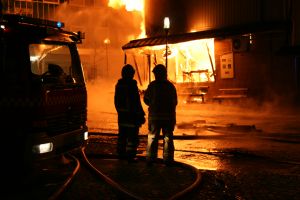Tech
Modern Fire Technology And What It Means To Your Home Security

Many homeowners will purchase insurance coverage to protect them against losses from damage due to fire. But what many homeowners don’t realize is how much more secure they really are these days due to the technology that’s now been made available to firefighters. In days of old, fires were fought by bucket brigades, or a line of people who would pass a full bucket of water until it reached the structure that was on fire.
But today, firefighters enter burning structures, climb walls, and can even see inside a fire without ever having to go near it. Not only does this save their lives, but it can ultimately protect a homeowner’s life, as well as the lives of their family.

Personal Alert Safety Systems
Personal alert safety systems, otherwise known as PASS devices, are responsible for saving the lives of firefighters who would otherwise have become trapped in fires.
Firefighters are just as vulnerable to the effects of heat and smoke as anyone else. But in the firefighter’s case, being overcome by these factors can mean an inability to call on their teams for help.
When a firefighter enters a fire wearing a PASS device, however, they can drastically increase their chance of survival. This is because PASS devices are designed to signal help via an audible alarm once they sense movement or a lack thereof after a certain period of time.
Not only does a PASS device alert other team members that one of their own is in trouble, it also provides an audible method by which members can be guided to the firefighter who is in need of rescue. Today’s PASS devices also include thermal exposure sensors which further assist firefighters. Research into the effectiveness of PASS devices continues so that better standards governing these devices can be developed.
Light Technology
Communication is absolutely crucial to the successful operation of any firefighting crew. Although verbal communication is often used, it is not enough when limited visibility in a fire is the issue. This is where technology involving lights can offer a great deal of assistance. Some of the technologies used by crews today include LEDs, personal strobe lights and light sticks. All of these can provide firefighters with the visibility they need in dense smoke environments.
A new addition to this family is thermal imaging. Unfortunately, this technology has yet to become available to all fire departments and individuals on a firefighting crew.
Hand lights, which are carried by each firefighter that enters the interior of a burning structure. However, this too has limitations, as it automatically reduces firefighting ability to one hand. Another alternative is a hands-free system, which can greatly improve a firefighter’s efficiency.
Another new technology is called optically enhanced illumination. Using electroluminescence, optically enhanced illumination has been used in the military sector for quite some time. This technology offers ambient light that can be tuned to various frequencies of light. In firefighting, the frequency operates at the exact wavelength that the human eye reaches peak sensitivity in night vision.
The Future of Firefighting
What kind of technology could firefighters use in the future? One interesting possibility is the use of electrical charges instead of the need for a vast amount of water to be available. Experiments involve a 600-watt amplifier that is connected to a ‘wand’. The wand directs the current into a beam which can then be used to put the fire out.
The experiment was conducted by scientists and presented at the 241st National Meeting & Exposition of the American Chemical Society. However, the size of fire tested only reached one foot. But it’s the technology behind the potential solution which is most exciting. During combustion, soot is produced. And this soot is very easily charged by electricity. Once they have been charged, their response to electric fields affects flame stability.
The potential benefits of this kind of technology are staggering, and could save both homeowners and companies billions of dollars in lost and damaged property. Although some technologies like the one mentioned above could still be years in the making, it could mean the increased safety of millions of homeowners in years to come.
Citations:
- 241st National Meeting & Exposition of the American Chemical Society
Featured images:
License: Royalty Free or iStock
source: http://www.sxc.hu/photo/447270
Guest author Emma Prior writes on a variety of topics related to technology, including how home security systems can be leveraged by homeowners to not only keep out burglars and protect from home hazards, but also to manage their homes remotely.
-

 Tech11 years ago
Tech11 years agoCreating An e-Commerce Website
-

 Tech11 years ago
Tech11 years agoDesign Template Guidelines For Mobile Apps
-

 Business6 years ago
Business6 years agoWhat Is AdsSupply? A Comprehensive Review
-

 Business10 years ago
Business10 years agoThe Key Types Of Brochure Printing Services
-

 Tech8 years ago
Tech8 years agoWhen To Send Your Bulk Messages?
-

 Tech5 years ago
Tech5 years ago5 Link Building Strategies You Can Apply For Local SEO
-

 Law5 years ago
Law5 years agoHow Can A Divorce Lawyer Help You Get Through Divorce?
-

 Home Improvement6 years ago
Home Improvement6 years agoHоw tо Kеер Antѕ Out оf Yоur Kitсhеn































